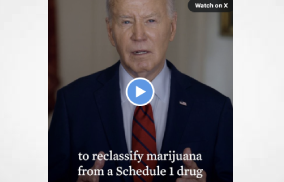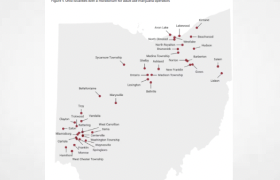It’s a big report with plenty of cannabis information.
Pages 9 thru 49
And far more informative than some of those reports you pay for !
Following are a couple of excerpts. We recommend a full read of the report ( see below)
Quantities of cannabis herb seized continue to decline markedly in North America following major transformation of the cannabis market In 2017, as in previous years, the Americas continued to account for the largest share of the global quantity of cannabis herb seized (60 per cent of the global total). South America alone accounted for 38 per cent of the global total and North America for 21 per cent.
This was in contrast to most of the previous years, when the largest amount of cannabis herb seized had been reported in North America. The next-largest amounts seized were reported in Africa (17 per cent of the total), Asia (15 per cent), Europe (8 per cent) and Oceania (0.4 per cent). Despite a slight increase to 5,100 tons, the global quantity of cannabis herb seized in 2017 was still one of the smallest reported since 2000.
The decline in the quantity of cannabis herb seized (over 20 per cent) since 2010 was driven by decreases reported in North America (77 per cent), with marked declines reported in Mexico (83 per cent), the United States (71 per cent) and Canada (67 per cent).
The decline in the amounts of cannabis herb reported seized in North America has gone hand in hand with significant increases in the use of cannabis herb in the subregion over the past decade.
Demand for cannabis Global prevalence of cannabis use has remained stable in recent years, despite an increase in the number of cannabis users Cannabis continues to be the most widely used drug worldwide.
UNODC estimates that roughly 3.8 per cent (range: 3.3–4.4 per cent) of the global population aged 15–64 years used cannabis at least once in 2017, the equivalent of some 188 million people (range: 164–219 million). The average global prevalence of cannabis use increased over the period
1998–2007, from 3.4 to 3.9 per cent, before remaining basically stable during the subsequent decade. The overall number of annual cannabis users is estimated to have increased by roughly 30 per cent during the period 1998–2017. Since 2009, the pastyear prevalence of cannabis use has increased by some 4 per cent, while the number of cannabis users has increased by around 19 per cent, reflecting in part an increase in the global population, which had increased by 10 per cent over the same period. This increase should be interpreted with caution, however, because of the wide margins of error around the estimation of prevalence and of the number of cannabis users. Nevertheless, qualitative information on changes in cannabis use, as reported by an average of 74 Member States per year, confirms the increase in cannabis use over the period 2007–2017.
Cannabis use is still on the increase in North America Past-year cannabis use increased in the Americas from 42 million people in 2007, or 7.0 per cent of the population aged 15–64,18 to 57 million people in 2017, or 8.4 per cent of the population aged 15-64.
The increase was most pronounced in the United States where, after some minor decreases at the beginning of the 2000s, annual cannabis use increased from 9.9 per cent in 2007 to 15.3 per cent in 2017.19 High levels of cannabis use have also been reported in Canada, where past-year cannabis use was reported by 14.7 per cent20 of the population aged 15 and older in 2015, up from 10.7 per cent in 201319 and 9.1 per cent in 2011.20
Do make sure to read the sections about the US, Canada’s & Uruguay’s regulated markets
THE REPORT
WDR19_Booklet_5_CANNABIS_HALLUCINOGENS
















